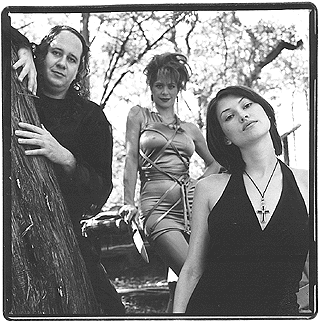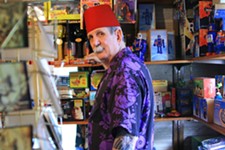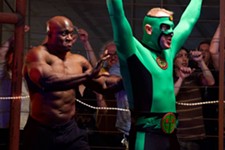Any Way You Slice It
Texas Chainsaw Massacre: The Next Generation
By Marc Savlov, Fri., Oct. 17, 1997
|
|
After three long years of languishing in limbo, the Austin-lensed film Texas Chainsaw Massacre: The Next Generation (originally titled The Return of the Texas Chainsaw Massacre) is finally seeing some sporadic, regional release under the auspices of independent distributor CFP. That would be cause for celebration, except for the fact that the film's executive producer, attorney Robert Kuhn, has until recently been involved in a bitter legal dispute involving Columbia/TriStar itself. Currently, the film (directed by Kim Henkel, who penned the original Texas Chain Saw Massacre for Tobe Hooper) is showing in less than 20 cities across the country, and the general feeling among cast and crew is that the production is getting a raw deal from the film's original distribution agreement with Columbia/TriStar. On top of that, the film has also endured some minor cutting at the hands of the studio, which excised a prominent backstory involving star Renee Zellweger's character Jenny and her relationship with her abusive father. The film, which opens today at the Dobie Theatre, may not be the "classic" some cast members refer to it as, but it's still a decent entry into the Chainsaw pantheon, filled with over-the-top performances from local actors such as Robert Jacks and Lisa Newmyer. It doesn't make perfect sense to everyone (what's up with that mysterious, third-act businessman from Hell?), but it does have its bloody, nasty moments. On the eve of the film's impending release, Jacks (who plays the infamous Leatherface), Newmyer (affectionately dubbed "meat-hook girl"), and director Henkel took time to reminisce on a shoot that redefined the term "rough" and speculate on its ultimate fate in the midst of legal limbo.
Robert Jacks: My first night on set I had to use a chainsaw for a couple of minutes. [The crew] had showed me that it just cuts like butter through these tree limbs. I tried it, and that was it. So I was up for my scene -- I had to cut through these saplings to get to Renee -- and I had to do this sort of viciously, and then run myself out of camera.
So I started to do it, I was hacking through these tree limbs, and suddenly everybody in the entire company leaves their posts because they thought I had gone insane. Absolutely everyone except for Levie Isaacks, the cinematographer, who realized that I knew what I was doing. To this day, half of them still think I really went crazy and the other half think, "Wow, this fag can really do this." That was pretty funny because I hadn't heard of anything like that happening on a movie set before.
Kim Henkel: Robbie's a big guy, and he's usually a very gentle, soft-spoken character, although he has his moments. Once he put on that mask and he got that chainsaw in his hands and we turned him loose, he was transformed. He was truly frightening swinging that thing around, even though the chain was not engaged, and he was cutting his way through those woods. It was the first time, I believe, that he had really cut loose with that thing in close quarters with the crew around. He seemed to be out of control, honestly. People were just scattering and diving behind trees and into the bushes right and left.
Lisa Newmyer: It was a crazy shoot. Very long. One thing that was interesting about it was that it was shot in sequence. You know how most films are shot totally the opposite -- you can shoot the last scene on the first day and like that, right? On this film, the beginning of the shoot was the beginning of the movie, and the end of the shoot was the end of the movie. So it was pretty exhausting from that point of view. The first couple of weeks were really fun, you know? It was all the easy stuff. And then, as it went on, we were doing mostly night shoots, in Bastrop, so we'd shoot from say, seven in the evening until seven – sometimes 10 – in the morning, the next day. So it got pretty grueling. And it became more violent. It just kind of progressed. It became more exhausting – and more disturbing – as the material got more physically demanding. It was fun, up to a point.
RJ: I remember the shoot was extended for a few weeks and then we had to come back a year later and do reshoots. The whole time, it was 17-hour days, out in the woods, in the dark, with bugs crawling all over you. The chainsaw was heavy – 40 pounds – so whenever I had to do running scenes, the crew would be off-camera holding a blanket up to stop me while a stunt man would grab the chainsaw.
We were all so emotionally damaged by the end of the third week or so that Renee and I called a meeting with the director and the producer because we were so beat up and so bruised up that we just couldn't take it anymore, you know, mentally or physically, which is unheard of. What you see in that movie is exactly what we went through. There isn't anything in there that's fake. It's all real.
LN: There's a scene where I'm on the porch swing and Leatherface [Jacks] comes up behind me and throws me into a meat freezer – that whole sequence was shot in 10-hour stretches. I couldn't move the next day.
Kim [Henkel] said that in the first film they did it with a pantyhose harness, but that didn't work this time, so they ended up making this pretty industrial harness for me, and it took us maybe two days to shoot because we couldn't get it right. It had to be shot as Robbie pulls me out of the freezer and it had to be smooth, it had to flow as he put me on the hook. He had to actually lift my body way up over the hook and pull down on it, and do it all looking natural.
KH: There were a lot of long, hard, hot nights. And then, when we finally got around to shooting in the days, I think Austin had been in a drought for god knows how long, something like 60 days and it was the middle of August, with temperatures in excess of 100 degrees. It was so hot the sand underfoot would burn your feet. It was pretty miserable out there. We had people falling down right and left from incidences of heatstroke if they weren't careful.
RJ: Working with the crew was actually pretty fun. Because of my role, I was able to deflect any kind of bullshit that they'd been given, and so they would beg me to throw a fit by nine or 10 in the morning so they could do all the shots inside. I'd find an appropriate time and then just throw a big fit so they'd close down the set. I really loved the crew. They were troupers.
KH: As far as the cuts that Columbia/TriStar made to the film before its release: The first scene, in which you see the principal character of Jenny [Zellweger] in her home situation, was excised entirely. Why, I don't know. You'd have to ask Columbia/TriStar about that. Her home life, in that scene, was shown to be pretty unpleasant, and I'd hoped that would resonate with what was going on later in the film. I've always described the film as a black comedy about dysfunctional families, and we see one side of it with Jenny's domestic life and the other side of it in the dilemma with the ghouls.
Not much else was changed in any radical way. Bits and pieces were knocked off the head and tail of a scene to shorten them up. There are a couple of scenes in the picture which I think come out just a little bit choppy as a result of it, but nothing too serious.
RJ: On the opening weekend in New York, Debbie Harry went with some of her friends, and she called afterwards and told me that they laughed and screamed and jumped and had a real good time. Chris Stein thinks it's the best out of all the films. Exene Cervenka adores it. Viggo Mortensen, Exene's husband who was in the third installment of the series, thought it was great. As far as people that I know who have seen it, they weren't just buttering me up about it, they really think it's hysterical. I think that it lives up to what it is, but, you know, I think it has to be promoted in that kind of a way.
LN: It is what it is. It's a classic B-movie. Twenty years from now it'll probably be as popular as the original. If you have a sense of humor, see it, if you don't like horror movies, then don't go see it.
KH: I had hoped that the film would benefit all of the people involved in it. I think it's really a good showcase for a lot of talent, not only the cast, but I also think we had some excellent work by some people in our crew. I had hoped it would lead to some recognition for all of those people involved, myself included. What has resulted, of course, has not served that purpose at all. And I think that's directly a result of the release being token at best.
Texas Chainsaw Massacre: The Next Generation opens at the Dobie Theatre Friday, October 17.









